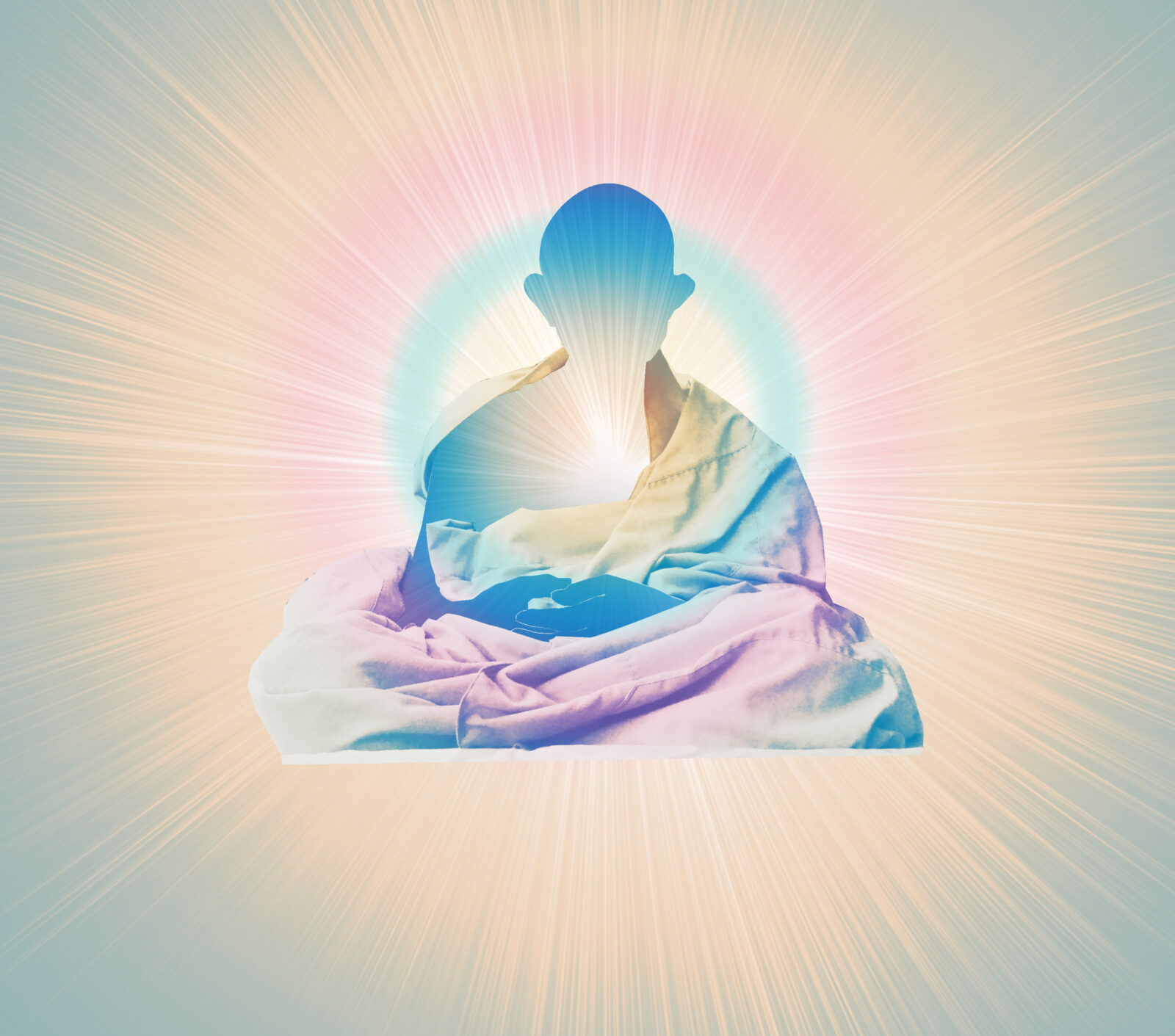


In what Tibetan Buddhists call tukdam (Wylie transliteration: thugs dam), experienced meditators die in meditative equipoise. Their bodies do not show the usual signs of death—such as smell, rigor mortis, or decomposition—for days or even weeks after their clinical deaths. They appear lifelike, and many even remain sitting upright in meditation posture. From the Tibetan Buddhist point of view, the meditators are resting in a subtle state of consciousness with an associated subtle material energy present in the body. They are still in the process of dying. Yet according to modern biomedical and legal definitions, they are dead. Many cases of tukdam have now been scientifically documented.
For my 2022 documentary film Tukdam: Between Worlds and research for my PhD in medical anthropology, I have been following the Tukdam Project, a groundbreaking scientific research initiative lead from the Center for Healthy Minds at the University of Wisconsin—Madison and headed by renowned neuroscientist Richard Davidson.* It has focused on documenting tukdam bodies and trying to understand why the decomposition process seems to be delayed. His Holiness the Dalai Lama initiated this multidisciplinary project, which has been carried out with Tibetan collaborators from Delek Hospital in Dharamshala and Men-Tsee-Khang (Tibetan Medical and Astro-Science Institute) traditional Tibetan medicine doctors in India. In recent years, Russian and Indian scientific collaborators have also joined the effort to understand tukdam scientifically.
In following the project, I have been struck by the differing expectations and even cross-purposes that the Tibetan and scientific parties seem to harbor. Tibetans hope the research may reveal something about a subtle nature of consciousness that continues beyond clinical and brain death, and which is held to be responsible for keeping the bodies fresh. The Dalai Lama also seems to be invested in this research because of its potential to reveal something about the nature of consciousness that transcends the brain-body complex and even this life.
IN TUKDAM, CLINICALLY DEAD MEDITATORS ARE SAID TO DWELL IN THE LUMINOSITY OF EMPTINESS.
While the non-decaying tukdam body signifies the presence of consciousness for Tibetans, this is not obvious from a biophysical scientific perspective. Indeed, the Center for Healthy Minds has been looking for possible residual activity in the brainstem—a primitive part of the brain not thought to be involved in consciousness—as a factor contributing to the unusual integration of the bodies. In 2021, the research team published a null-finding stating they had not found any activity in the brain so far. Compelled to operate within a biophysical paradigm, scientists are also interested in possible changes to cell metabolism and breakdown, brought about by years of meditation practice, as perhaps contributing to the pristine postmortem state of tukdam bodies. But taking samples from the bodies has so far been out of the question due to cultural sensitivity and the sacredness of these deaths. Tibetans are concerned that invasive procedures could disturb the postmortem meditative state and the potential it carries for spiritual liberation and achieving a good rebirth.
An exchange from Tukdam: Between Worlds illustrates some of the tensions and cross-purposes with which the scientists and Tibetan parties have been operating, although there have been developments in the research and collaboration since the time of shooting in 2019 to early 2020. The scene shows a meeting where Dr. Dylan Lott, who was then the Tukdam Project manager in India, presents the current state of the research and its findings to Tibetan project collaborators. The Dalai Lama’s personal physician, Dr. Tsetan Dorji Sadutshang, expresses frustration over the lack of results from years of research and what he sees as a misguided approach to explain tukdam in neuroscientific terms. According to the Tibetan view, something far more subtle than the “gross” mind related to the brain and senses is responsible for the physical signs of tukdam.
Dr. Tsetan:
To me, from my understanding of His Holiness’ hope from this project, really is to have some proof that there is some sort of consciousness . . . or a mind continuing, that goes on beyond this life, basically. The only first kindergarten step is really to say: Is there a difference between a gross mind and a subtle mind?
Dr. Lott:
We cannot prove rebirth. We cannot prove mind. We cannot prove subtle mind. What we can do is look at the effects of those practices on the body that are unusual and that Western science, or medical science, doesn’t have a good explanation for.
As is the case with science, it is not obvious to all Buddhist traditions that a non-decomposing body proves the presence of consciousness. The medieval Chinese Chan tradition, for example, also records miraculously preserved meditators’ bodies. These did not, however, signify present consciousness, which according to widespread Buddhist doctrine, departs immediately at death to be reborn or to enter nirvana. Here the body is preserved due to purification by religious practice and virtue accumulated while alive.
There is something paradoxical in taking the non-decaying body as evidence for a consciousness that transcends the body and physicality. However, here we should be careful to note that in the Tibetan Buddhist tantric tradition different levels of mind are associated with different types of embodiment. Subtler forms of consciousness are associated with tantric subtle bodies or physiologies familiar to advanced tantric practitioners. As these are in a way two sides of the same coin, mind always affects body and vice versa. Such subtle bodies are arguably different from, though connected to, the “gross” biomedical body that scientists work with, which also shows effects of subtle levels of mind and embodiment.
Tibetan tradition exhibits a great deal of sophistication and specificity when it comes to signs or ways of ascertaining whether a person is in tukdam—as well as when it ends. The body will slump over if it was sitting upright; smell and normal signs of decomposition will appear. In accordance with subtle tantric physiology, red and white liquids may come out the nostrils and genitals. These are all signs that even the most subtle consciousness has departed. For Tibetans, final death occurs when the mind leaves the body, which could be weeks after clinical death in cases of tukdam,or hours to days for “normal” deaths.
There is also a tantalizing tradition of ending tukdam that could be seen as indicative of consciousness. If tukdam goes on too long, it may be ended by ringing a bell near the ear of the deceased practitioner, saying certain prayers, or asking them to end their meditation. The body then reportedly collapses and decomposition takes over. This could imply responsivity on the part of the deceased meditators, bearing on questions of consciousness. In an interview piece that did not make the final cut of my documentary, the Dalai Lama recounted this story:
One lama I had a very close connection [with] . . . Last few years his physical [condition] was very, very weak. And then in my last meeting in Mongolia, I told him, “Now time has come. You have to think about your next life.” Then around the end of the year, with New Year soon, I received one message from him: “When I should die? Where I should die?” . . . Quite silly, “where I should die, when I should die!” Then accordingly I also answered a silly sort of answer, “You should die in Mongolia. The time, not end of the year but the beginning of the year, New Year.” He exactly, I think in the first week of the New Year, then he died. Then I sent my representative with my [ceremonial silk] scarf. I think it took two days . . . When my representative reached his place and put the scarf which I sent . . . on his neck, then he ended his tukdam. [Dalai Lama makes gesture of body slumping over.] So these are quite mysterious things. There are some elements to control. It is quite obvious as soon as the tukdam ends, the physical [body] clearly shows real death, the real corpse.
People often report feeling a meditative calm or presence when entering the room of someone in tukdam. Some of the American scientists researching tukdam also said they felt it. But such things seem difficult to measure and to be firmly in the realm of first-person experience as opposed to the third-person observation of natural science. This does not, however, necessarily make such perceptions less real. As another Tukdam Project collaborator, senior Tibetan medicine doctor Tsewang Tamdin, told me, “Just because something is invisible does not mean it does not exist.”
As in life and death, the dynamic of presence and absence is central to tukdam. Here we come to a basic conflict between the Tibetan Buddhist and current biomedical views of death. For the latter, death unequivocally means absence. Once the heart shuts down, brain death quickly follows “unless it’s been inflicted before the heart stopped” and the person is gone. But for Tibetan Buddhists, there is presence, or mind, in death.
*Richard Davidson is a member of the Rubin Museum’s advisory board.

Donagh Coleman is a Finnish-Irish-American filmmaker. Previous award-winning documentaries with international festival and TV exposure include Stone Pastures and A Gesar Bard’s Tale. Donagh’s films have been shown by the European Commission and museums such as MoMA and the Rubin Museum. Donagh is currently doing a PhD in medical anthropology at University of California, Berkeley and holds degrees in philosophy and psychology and music and media technologies from Trinity College Dublin, as well as a master’s in Asian studies from University of California, Berkeley.
Get the latest news and stories from the Rubin, plus occasional information on how to support our work.